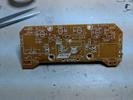I now have Hi-Tech C running under piklab. I'm glad that I tried it now.
After messing around for an evening or two with a stupid problem where bitwise OR assignments "|=" on PORTA and reading the value on PORTA fails, I decided that maybe SDCC was bugged. The OR would appear to work, but on closer inspection they actally zeroed the byte I was working on and only set the single bit that I was specifying. I installed MPLAB 8.73 with the Hi-Tech C compiler for 10/12/14/16 MCUs. There was trouble initially with wine as the picc.exe executable lived under "Program Files", So I moved the folder down to the home directory. This brought me a step closer as piklab verified the files exist - when it came to compile time piklab still tried to execute the linux executable rather than the .exe. I symlinked sdcc.exe to sdcc and libr.exe to libr and it now works fine.
Straight away I tried a compile (which failed) and then started the port from sdcc to picc. Once I had finished, the project built ok and I burned the hex to the pic (an 'f88). Lo and behold the same error occurred!
The code I used was originally an experiment with the adc which I wrote previously to try out SDCC. After combing the net I found a FAQ on the Hi-Tech website which described exactly my fault! I had a read of the FAQ and then checked out my code. Doh! I had remmed out the ANSEL declaration rather than implicitly setting it to 0. Facepalm.













